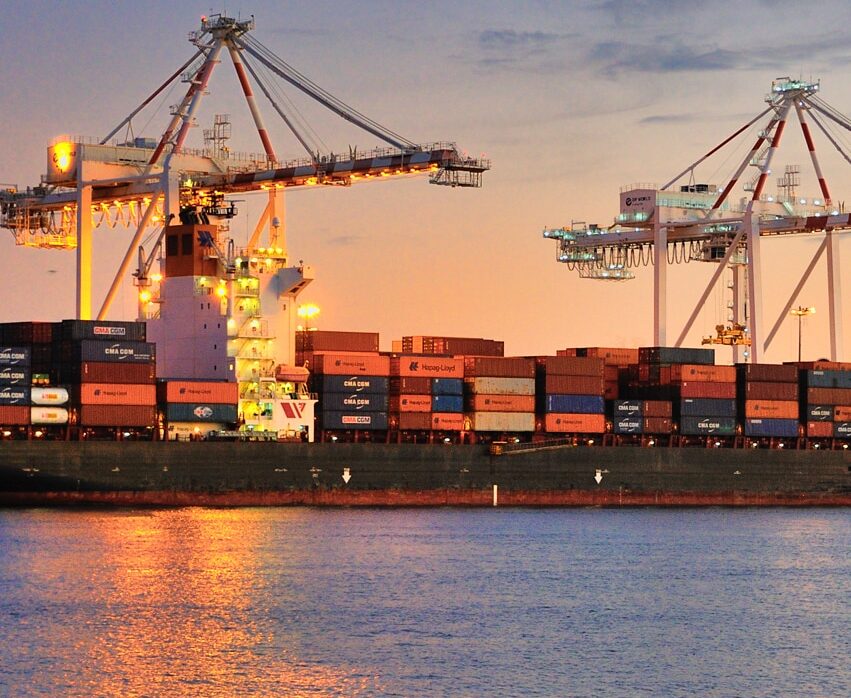Global shipping costs falling at rates not seen ‘in decades’ in lead up to Christmas
The cost of sea freight is plummeting as countries raise interest rates amid fears of a global recession, but it may not necessarily result in cheaper imports for Australian consumers, stakeholders say.
Key points:
- Global shipping costs are falling fast after spiking during the pandemic
- Australia’s shipping costs are also falling but comparatively less than global markets
- Exporters hope to regain access to markets they lost due to prohibitive costs
Nearly 80 per cent of the world’s trade is transported in 12-metre shipping containers but costs soared during the COVID-19 pandemic, peaking in September last year.
Brian Hack is the director of Western Australia-based EES Shipping, one of Australia’s major international freight forwarders.
He says global shipping costs are now falling “drastically”, and are doing so in the lead up to Christmas for the first time in decades.
“All these companies that were buying big and trying to bring in lots of Christmas stock have basically slammed on the brakes and cut orders, so there’s heaps of extra capacity within the freight world,” Mr Hack said.
“What that means is shipping lines don’t want to send vessels half empty. They prefer them to be full, so the easiest way for them to gain business is to drop rates.
“It seems that they tumbled a lot faster than when they went up a few years ago.”
Mr Hack said the biggest fall had been in trans-Pacific and trans-Atlantic freight.
It previously cost up to $US20,000 [$31,894] to send a 12-metre container from China to the United States.
This had fallen to $US3,000 or $US4,000, which Mr Hack said was almost pre-pandemic levels.
Falls expected to continue
Mr Hack said in Australia 12 months ago it cost $15,000 to send a 12-metre container to China. This was now $6,000, which is still much higher than pre-COVID costs of about $2,000.
“Prices have dropped significantly [for Australia] but it’s not the rates that we had pre-pandemic,” he said.
“We’ll probably see rates continue to fall, which is quite interesting for this time of year because it’s pre-shopping season.
“Normally rates are on the increase for this time of year … I don’t think I’ve seen them [dropping at this time of year] in decades.”
Mr Hack said it would be “interesting” to see if freight savings were passed on to consumers, but he said the falling US dollar would negate some savings.
Relief for export businesses
John Orr from Premium Grain Handlers said it was a relief to see global container prices fall.
Mr Orr’s business model involves buying grain from farmers and sending it to international markets in shipping containers.
When container prices began rising at the end of 2020 and spiked last year, Mr Orr found himself priced out of his traditional markets in the European Union and Middle East.
“Into India it’s costing us $240 a tonne, relative to $50 a tonne [pre-COVID] just for the ocean freight component of our transport,” he said.
“Such a big increase in freight cost has a big impact on our ability to supply these markets.”
Mr Orr said prior to COVID, he was sending grain to the Middle East and Indian subcontinent regions, but when freight rates increased dramatically, many customers could not absorb price increases.
Along with the increasing availability of containers, he said falling costs would help his company return to markets it had not been competitive in.
“The drop in freight rates will enable us to pass those international prices to growers, which is something I’m sure growers will look forward to,” Mr Orr said.
Further relief in easing tension
Mr Orr said his company was able to send grain to China during the price hike.
“Anything east of Singapore we were able to continue to supply, but the volumes that we were able to supply was larger into China, where the shipping companies wanted their containers sent,” he said.
But Mr Orr said strained diplomatic relations between Australia and China had created concerns for the company, and did result in a returned shipment of triticale to Australia from China.
He said he was relieved to see tensions ease.
Aside from container prices, Mr Orr said there were other increased costs in the shipping supply chain, such as container terminal charges.
He said it now cost $120 to book a container at a wharf, where previously it had cost nothing.

